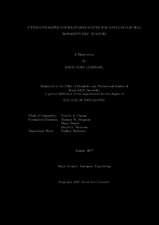| dc.description.abstract | A time-linearized CFD solver for analyzing rotordynamics of gas seals is presented offering an improvement over existing linearized CFD solvers. Previous linearized solvers required structured grids and axisymmetric domains, limiting the complexity of the geometries of the seals that could be analyzed. A preexisting, full-order, in-house CFD solver was available which operated on fully 3D and unstructured grids and was well suited for complex seal geometries. A linearized version of the in-house code is developed as a companion to the full-order solver, retaining its unstructured and fully 3D features. Furthermore, boundary conditions are developed for the linearized solver allowing it to take advantage of the geometric symmetries that were required by earlier linearized solvers without necessarily being limited to them. Additionally, a linearization procedure is presented which is general enough to be used for the many various features of the full-order solver. As the in-house code continues to be developed and new features are included, the same linearization procedure can be used to keep the companion code up to date. The full-order, in-house solver and the time-linearized companion code combine to become a powerful CFD-perturbation solver accessible to all complexities of seal geometries.
This dissertation also presents an analytical formula that describes features of cavity flow as it pertains to annular gas seals in order to progress the fundamental understanding of the flow physics of roughened seals. An existing semi-empirical analytical formula, developed to describe the cavity flow of aircraft bomb bays, is modified using the full-order, in-house CFD solver. The numeric model is validated against experimental measurements and used to adjust empirical parameters of the formula to match cavity flow conditions unique to annular seals. The modified analytical formula is able to predict features of cavity flows found in annular gas seals better than existing formulae.
Finally, the companion, time-linearized CFD solver is verified using two simple cases and the combined full-order and time-linearized CFD-perturbation solver is used to predict rotordynamic properties for two gas seal geometries. The first case used to verify the linearized solver is a channel flow with an oscillating back-pressure and the second is a stationary flow with an oscillating wall. The first gas seal case the combined CFD-perturbation solver is used for is a straight seal based on the High Pressure Oxidizer Turbopump (HPOTP) of the Space Shuttle Main Engine (SSME). The second is a stepped labyrinth seal. The rotordynamic predictions are compared with established bulk-flow models of the two cases and conclusions are presented. | en |


